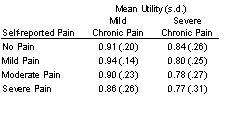| Meeting Brochure and registration form SMDM Homepage | |

|

|
|
||||
METHODS: We presented mild and severe pain scenarios to Internet users drawn from a panel designed to represent the US Census, stratified based on whether they reported having head or back chronic pain. We randomized respondents to receive the mild or severe pain scenario in a between-subjects experimental design. 2656 respondents provided a utility for one of the scenarios using the time tradeoff method (TTO). We tested whether respondents with different levels of pain (none, or mild, moderate, or severe pain) placed different utilities on living with mild or severe chronic pain.
RESULTS: Utility ratings are shown in the table by the level of pain reported by respondents and for each scenario. Based on ANOVA results with follow-up contrasts, ratings from respondents with severe pain were lower compared to ratings from respondents with no pain or mild pain (p's <0.01) when rating the mild chronic pain scenario. Similarly, ratings from respondents with moderate or severe pain were lower than ratings from respondents with no pain (p's<0.02) for the severe chronic pain scenario.
CONCLUSIONS: As predicted, the discrepancy between patient and public ratings of pain resulted in a reversal of the established discrepancy seen in prior research. Our findings have significant implications for health policy decisions that rely on valid rankings and provide insights into the question of whose values to use.

See more of Oral Concurrent Session A - Quality of Life and Utility Theory
See more of The 27th Annual Meeting of the Society for Medical Decision Making (October 21-24, 2005)